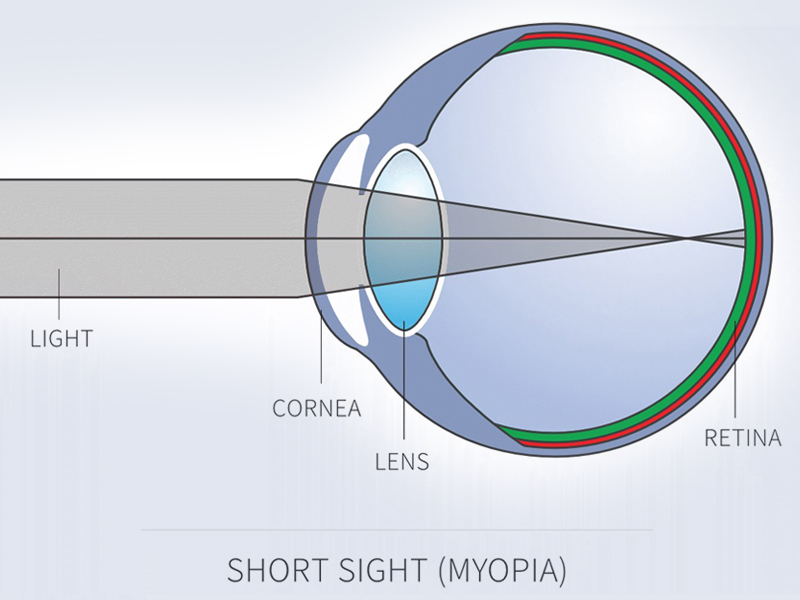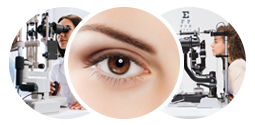Refractive Errors of the Eye: Causes, Types, Symptoms, and Treatment
Refractive errors are common vision problems that occur when the eye is unable to focus light properly on the retina. This leads to blurred vision and other related symptoms. These errors result from the shape of the eye preventing light from bending (refracting) correctly. The primary types of refractive errors include myopia, hyperopia, astigmatism, and presbyopia. According to the World Health Organization (WHO), refractive errors are among the leading causes of visual impairment worldwide, affecting people of all ages and demographics.
Causes of Refractive Errors
Refractive errors occur due to various factors, including:
-
Irregular shape of the eyeball: A longer or shorter than normal eyeball affects how light rays focus on the retina.
-
Corneal abnormalities: An irregularly shaped cornea changes the way light enters the eye.
-
Lens issues: An altered shape or stiffness of the lens can impact focusing ability.
-
Genetic factors: A family history of refractive errors increases the likelihood of developing similar vision problems.
-
Aging process: Changes in the lens due to aging can cause presbyopia, affecting near vision.
-
Environmental influences: Prolonged screen time, reading in poor lighting, or excessive near work may contribute to worsening refractive errors over time.
Types of Refractive Errors
1. Myopia (Nearsightedness)
Myopia is a condition in which close objects appear clear, but distant objects appear blurry. It occurs when the eyeball is too long or the cornea is too curved, causing light to focus in front of the retina instead of directly on it.
Symptoms:
-
Blurred vision when looking at distant objects
-
Squinting to see clearly
-
Eye strain and headaches
-
Difficulty driving at night
Risk Factors:
-
High levels of close-up work, such as reading and screen use
-
Limited outdoor activities, particularly in childhood
-
Genetic predisposition
2. Hyperopia (Farsightedness)
Hyperopia is the opposite of myopia. Distant objects appear clearer than near ones because the eyeball is too short or the cornea has too little curvature, causing light to focus behind the retina.
Symptoms:
-
Blurred vision for close-up tasks like reading
-
Eye strain and fatigue
-
Headaches after prolonged close work
-
Difficulty focusing on near objects
Risk Factors:
-
Genetic inheritance
-
Congenital eye structure variations
3. Astigmatism
Astigmatism occurs when the cornea or lens has an irregular shape, leading to distorted or blurred vision at all distances. Instead of light focusing on a single point, it scatters, causing visual disturbances.
Symptoms:
-
Blurred or distorted vision at any distance
-
Difficulty seeing at night
-
Eye strain and discomfort
-
Frequent headaches
Risk Factors:
-
Corneal irregularities present at birth
-
Eye injuries or surgeries that alter corneal shape
4. Presbyopia
Presbyopia is an age-related condition in which the eye gradually loses its ability to focus on nearby objects. It typically develops around the age of 40 due to a stiffening of the eye’s lens.
Symptoms:
-
Difficulty reading small print
-
The need to hold reading materials at arm’s length
-
Eye fatigue while reading or using screens
-
Frequent headaches
Risk Factors:
-
Natural aging process
-
Underlying eye conditions
-
Chronic exposure to excessive near work
Diagnosis of Refractive Errors
A comprehensive eye examination is essential for diagnosing refractive errors. The following tests are commonly performed:
-
Visual acuity test: Measures how clearly a person can see at various distances.
-
Refraction test: Determines the correct lens prescription using a phoropter and retinoscope.
-
Keratometry and corneal topography: Measure the curvature of the cornea, useful for detecting astigmatism.
-
Slit-lamp examination: Assesses the overall health of the eye.
-
Ophthalmoscopy: Examines the retina and optic nerve to detect underlying eye diseases.
Treatment Options
Refractive errors can be corrected using various methods, including:
1. Eyeglasses
Eyeglasses are the simplest and safest way to correct refractive errors. Lenses are customized based on the severity of the condition and provide clear vision. Anti-glare coatings, blue light filters, and progressive lenses are additional options that enhance visual comfort.
2. Contact Lenses
Contact lenses offer a wider field of vision and are a popular alternative to eyeglasses. They come in different types, including:
-
Soft lenses: Comfortable and flexible, suitable for most people.
-
Rigid gas-permeable lenses: Provide sharper vision and are beneficial for astigmatism.
-
Toric lenses: Specially designed for astigmatism correction.
-
Multifocal lenses: Address presbyopia by providing multiple focusing zones.
3. Refractive Surgery
Surgical options reshape the cornea to improve vision. Common procedures include:
-
LASIK (Laser-Assisted In Situ Keratomileusis): Uses a laser to reshape the cornea for better light focus.
-
PRK (Photorefractive Keratectomy): Removes a thin layer of the cornea to reshape its curvature.
-
ICL (Implantable Collamer Lens): An artificial lens is implanted in the eye for permanent correction.
-
SMILE (Small Incision Lenticule Extraction): A minimally invasive procedure to reshape the cornea.
4. Orthokeratology (Ortho-K)
This non-surgical treatment involves wearing specially designed rigid contact lenses overnight to reshape the cornea temporarily, providing clear vision during the day. It is particularly useful for myopia control in children.
Prevention and Eye Care Tips
While refractive errors cannot always be prevented, good eye care can reduce strain and maintain eye health:
-
Get regular eye exams to detect issues early.
-
Maintain proper lighting while reading or using digital screens.
-
Follow the 20-20-20 rule: Every 20 minutes, look 20 feet away for 20 seconds to reduce digital eye strain.
-
Eat a diet rich in vitamins A, C, and E for eye health.
-
Protect eyes from harmful UV rays by wearing sunglasses.
-
Avoid prolonged screen time and take frequent breaks.
-
Encourage outdoor activities for children to reduce the risk of developing myopia.
Conclusion
Refractive errors are common but treatable vision problems. Understanding their causes, symptoms, and treatment options helps individuals maintain good eye health and improve their quality of life. If you experience any vision problems, consult an eye care professional for an accurate diagnosis and appropriate corrective measures.


